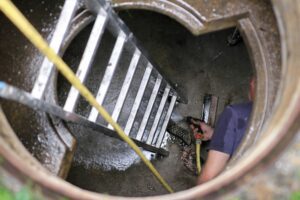A cistern requires occasional maintenance. The rainwater supply system also requires maintenance. In this article, discover how to clean your rainwater cistern.
When should I clean my cistern?
The cleaning of your cistern should be considered approximately every 10 years. It is when the layer of sediment reaches about 5 cm that you should consider cleaning your cistern.
It is important to avoid cleaning a cistern too frequently. Cleaning the cistern eliminates important micro-organisms that are responsible for the “health” of the water.
Cleaning your rainwater tank by your own
Since it is expensive to hire companies to clean a rainwater cistern, many garden and home owners prefer to do the cleaning themselves.
Before taking action, some organization and planning is required. A list of materials that need to be available for cleaning is essential.
Materials for cleaning a cistern :
- Flashlight
- Rubber boots
- Submersible pump, vacuum pump, dirty water pump
- Bucket
- Shovel
- High pressure cleaner
- Rope
- Climbing harness
- Ladder
Cleaning the tank
Safety tip: Never clean the tank alone!
If you have all the tools at hand, call in a friend or acquaintance. In some circumstances, cleaning a tank can be life-threatening. For example, if there is too little oxygen in the empty tank, you may pass out.
Never work alone! A helper, who also takes care of ancillary work such as distributing flashlights and the like and supervises rappelling into the tank, can be helpful.
Empty the tank to clean it
First, turn off the rainwater system pump and water supply.
Then pump the rainwater out of the cistern. The rainwater is pumped out to about 30 cm.
The remaining water is usually very dirty, because the bottom of a rainwater cistern is often covered with a black layer, the so-called sediment layer. In order to pump out the dirty water, the dirty water pump is now used. This pump can transport the dirt particles upwards without damaging the pump.
Before using the dirty water pump, stir up the sediment layer with a pump and/or a broom.
As a dirty water pump, choose a pump that is powerful enough (in watts) to handle large quantities of dirty water.
Descending into the cistern to clean it
 Wait before proceeding, as the tank must be vented for at least an hour due to the possible presence of gas.
Wait before proceeding, as the tank must be vented for at least an hour due to the possible presence of gas.
After that, descend into the tank. Either rappel down or use a ladder. The legs of the ladder should be wrapped with rags to prevent damage to the bottom of the tank.
Before descending, plan to put on a climbing harness with a rope. If you pass out, it is very difficult to carry you out of the tank.
Using a bucket and shovel, the remaining black, muddy ground cover (sediment) is carried out of the tank. The collected sediment can be used in the garden because of its fertilizing properties.
Clean the tank with a pressure washer
Use the pressure washer to clean the walls and bottom of the rainwater cistern. The inlets should also be cleaned to prevent rotting and blockages.
Pump out the dirty water from the cleaning with the dirty water pump.
Once cleaned, the cistern is again ready to receive rainwater and store it in good conditions.
Conclusion
The cleaning of an underground rainwater cistern can be done by a professional or by yourself if you respect the safety instructions.
With two people and a little bit of equipment, you can remove the sediments and make sure that your cistern is perfectly clean.